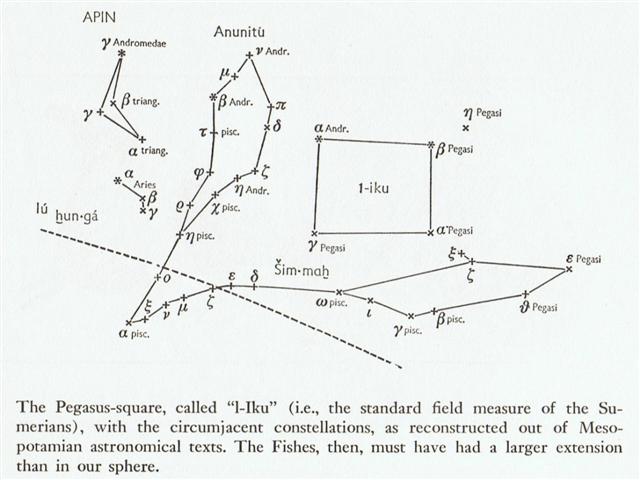2. Algenib is not exactly below Sirrah but nearly so. Both stars could once have represented 'time zero' (spring equinox north of the equator):
In G a new glyph line (b7) follows, and we can guess it refers to the new season. South of the equator it could be the beginning of the quarter beyond autumn equinox. Line b6 is number 8 + 6 = 14 from the beginning of side a. Number 14 reflects a fortnight and a greater such fortnight would be a suitable cycle for Moon. Tamaiti (the little child) in Gb7-3 is positioned as 'one more' than 14 * 29½ = 413. We should also notice how the old season seems to leave the day after, illustrated as a hau tea without eyes. The little child (the beginning of a new season) evidently arrives just before the old one leaves. In the complex glyph Gb6-27 there is a little tao at top center of the frontal sign. This tao is attatched to the curious sign below. Perhaps the following glyph represents the day when the old ruler leaves. 64 + 411 = 475 = 19 (Sun) * 25 (Saturn). By the way, in the Egyptian 'sign vocabulary' there is (according to Wilkinson) a form of the eye which I think resembles the tao type of glyph:
Possibly this Egyptian eye sign was used in rongorongo for the eye of Sun. The straight 'rays' below look like those of hau tea:
For various reasons, though, I suspect the standard hau tea glyph represents the white light of night from Moon rather than the red light from Sun (which presumably is described by the tapa mea glyph type). Sirrah ('The Woman in Chains') and Algenib were not only close together by the measure of right ascension but they were also the corners of one side of the square of Pegasus ('the Bucket'), thus they belonged together and could be considered as a single sign: ... Al Birūni quoted it, with δ (α Andromedae), as Al Fargh al Thāni, the Second, or Lower, Spout, i.e. of the Bucket. This also is the title of the 25th manzil, but appears in Professor Whitney's list as Al Fargh al Mu'hir, the Rear Spout, and in Smyth's as Al Fargu ...
Likewise should we perhaps consider the last 3 glyphs in line b6 as a unit. Sirrah is positioned at 00h 06m which translates into day number 1.5:
Equuleus, the foal with a red face, is in a similar situation, close to Pegasus because the horses belong together, and they really constitute a single sign with 2 parts. Equuleus, the little red foal - aka-tyan, 'little red one', means baby in Japanese - is rising earlier than the old one (who maybe has wings in order to be able to fly up to heaven). Algenib ('the wing') could represent the old year and Sirrah the new year, because Algenib is rising slightly later than Sirrah. Pegasus is only half a horse and I guess we therefore should change the table into:
The old Pegasus season ('horse') exhibits only a reversed front and she has no 'tail'. Or we could say that her 'tail' is in Andromeda. |
||||||||||||||||||||||||||||||||||||||||||||||||||||||||





